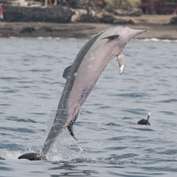International collaboration working to enhance protections for spinner dolphins

An international study involving researchers from Western Australia and the United States has unlocked a key behavioural schedule in spinner dolphins, which could provide crucial insight to conservation measures for the free-ranging animals.
Spinner dolphins
are famous for performing spins when leaping high out of the water and are a major draw card in Hawaii's $14billion tourism industry. Researchers from Murdoch University- in partnership with Duke University - studied the
"The dolphins mainly rest between 10.00 and 16.00 upon their return to sheltered near shore habitats. We also observed that socialising behaviour occurred mainly in the early mornings and late afternoon within bays," said Dr Julian Tyne from the Murdoch University Cetacean Research Unit.
"Reinforcing social bonds and social cohesion between the dolphins may be important for success of their cooperative night-time foraging activities.
"We are not aware of any other cetacean species that partitions its behavioural activities in such a temporally and spatially constrained manner on a 24-hour basis."
Dr Tyne said such constraints may render spinner dolphins less able to compensate for disruptions to their behavioural schedule.
"Over the last 30 years human activities have increased significantly in Hawaii, but the spinner dolphins still inhabit those areas that are important for resting. Recent abundance estimates are lower than all previous estimates indicating a possible long-term impact," continued Dr Tyne.
"This small genetically isolated spinner dolphin population is chronically exposed to human activities for more than 82 per cent of the time during day time hours. To our knowledge, these are the highest reported exposure rates of any free-ranging coastal dolphins to human activities.
"Human activities can affect the health of individuals through lost time conducting important behaviours like foraging and resting, leading to negative impacts on vital rates and population viability.
"The constrained behavioural pattern displayed by the spinner dolphins may make them less able to compensate for disturbance, compared with species that display a more variable behavioural pattern."
The United States National Marine Fisheries Service (NMFS) announced plans to protect the spinner dolphins in Hawaii from human disturbance by proposing a rule which prohibits swimming with and approaching a Hawaiian spinner dolphin within 45m, instead of time-area closures.
"Quantification of the spinner dolphin behavioural schedules provides critical insight for conservation measures that aim to mitigate the effects of human disturbance," Dr Tyne added.
"It is therefore essential that NMFS consider the constrained nature of the spinner dolphin's daily behavioural schedule when proposing rules to reduce harassment from human activities."
Provided by Murdoch University




















